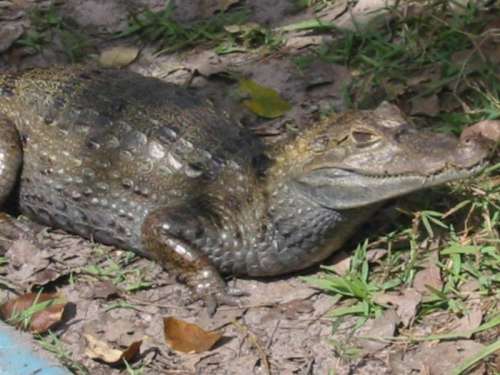Birds
Parrots
Blue Front Amazon
Mammals
Cats
Cougar
Leopard
Lion
Lynx
Tiger
Large Mammals
American Black Bear
Camel
Medium Mammals
Coatimundi
Raccoon
Ring-tailed Lemur
Two-Toed Sloth
White Nosed Coati
Primates
Vervet
Reptiles
Crocodile Family
American Alligator
Caiman
Lizards
Bearded Dragon
Blue-Tongued Skink
Crocodile Monitor
Leopard Gecko
Snakes
Non-Venomous
Ball Python (Royal Python)
Venomous
Copperhead
Eastern Diamond-back Rattlesnake
Northern Coral Snake
Pygmy Rattlesnake
Turtles
Tortoises
Gopher Tortoise
|
 |
Caiman
Caiman Crocodilus
Kingdom: | Animalia | Phylum: | Cordata | Class: | Reptilia | Order: | Crocodilia | Family: | Alligatoridae | Genus: | Caiman | Species: | Crocodilus |
|
Description
The caiman is small in comparison to other lizard species. It has a short tail and a short, smooth head with a high skull and upturned snout. They also have a pronounced overbite. Their irises are generally brown but can take on greenish tinge. Juveniles are brown with banding; adults have brown heads, and their jaws have white bands. Caimans closely resemble alligators except for the small bony scales embedded in the skin of their belly.
Click
Here to See Caiman Pictures
Average Statistics
Length | 7 ft. | | Weight | 70 lbs. | Geographic Range | Caimans inhabit Bolivia, Brazil, Colombia, Ecuador, Guyana, Peru, Surinam and Venezuela. They live in freshwater rivers and streams.
Escaped pet caimans can be found in the wild in South Florida and Louisiana. |
DietCaimans in the wild often eat fish but like many crocodilians they are very opportunistic and eat whatever happens to be nearby of the right size. OffspringFemale begins constructing nests out of available vegetation and mud before the onset of the annual rains; incubation lasts 90 to 115 days ? hatchlings emerge as water level rises from rains and disperses over wide range.
Newly hatched young are coated with a slow-drying, protective mucus layer and may not enter water until the end of the first day; when it's time, the female will open the nest and move the juveniles to water.
There is a high mortality rate among juvenile caimans, but adult mortality is very low. Jaguars and other large carnivores prey on the caiman. Relationship with HumansThe caiman is the most populous of the alligatoridae family. |

